1 An important contribution of Fiedlers research on the cont
1. An important contribution of Fiedler\'s research on the contingency model of leadership is that it: a. uses weights which are determined in an arbitrary manner in order to determine situation favorability. b. goes beyond the notion of leadership styles to try to show how styles fit a situation. c. recommends medium least preferred coworker leaders as they are more effective in many situations. d. is clear about how the model will work over time. 2. Which of the following characteristics was explored by the studies evaluating the characteristics of the leader-member exchange relationship? a. Income b. Educational qualification c. Value agreement d. Recruitment process 3. Which of the following is a characteristic of entrepreneurial leaders? a. They are concerned with innovation and creativity. b. They are interested in maintaining the status quo. c. They avoid taking risks and are unwilling to stretch themselves. d. They tend to be dependent on their followers. 4. An important aspect of leadership is: a. dictating changes required in an organization. b. maintaining a passive relationship with followers. c. maintaining the status quo and not creating change. d. influencing others to come together around a common vision. 5. It becomes easier for people to see their own opportunities for leadership when they: a. start seeing leaders as individuals who are above others. b. understand that the concept of leadership cannot continue to develop. c. stop equating leadership with greatness and public visibility. d. comprehend that leadership involves maintaining the status quo. 6. Erica, a team manager, was known for heading projects with diligence and conscientiousness. However, she was insensitive and excessively ambitious. She did not take feedback in a constructive manner. As a result, this prevented her from moving forward in terms of her career since she had problems communicating with her team members and motivating them. In the context of the given scenario, which of the following phenomenon does Erica experience? a. Communication apprehension b. Fear-based motivation c. Paradigm change d. Derailment Name: Class: Date: Quiz 1: Chp 1-3 (Fall 2015) 2 7. Which of the following statements is true of the contingency approach to leadership? a. A leadership style that works in one situation will work in all situations. b. These approaches seek to investigate traits that can improve performance in all situations. c. The needs, maturity, and cohesiveness of followers have been identified as a key contingency. d. These approaches hold that behavior that is effective in some circumstances is effective under all conditions. 8. Stage two in the development of the individualized leadership theory explored the _____ in more detail. a. vertical dyad linkage model b. partnership building c. leader–member exchange d. entrepreneurship model 9. Which of the following statements is true of leaders who work collaboratively? a. They learn to keep the lines of communication open. b. They wield their authority rather than using influence. c. They encourage internal competition and aggressiveness. d. They hoard power rather than share it. 10. Which of the following is a difference between leader behavior toward out-group members and in-group members? a. Leaders assign interesting assignments to out-group subordinates, whereas leaders assign primarily routine jobs to in-group subordinates and monitor their work closely. b. Leaders usually impose their views on out-group subordinates, whereas leaders sometimes defer to in-group subordinates\' opinions. c. Leaders give specific directives for how to accomplish tasks and attain goals to in-group subordinates whereas leaders trust out-group subordinates to use their own approaches in solving problems. d. Leaders listen to suggestions and ideas given by in-group subordinates, whereas little interest is shown in comments and suggestions given by out-group subordinates. 11. The belief that leaders were born with certain natural abilities of power and influence characterizes the _____ of leadership. a. Great Man theories b. trait theories c. behavior theories d. contingency theories 12. Which of the following statements is true of individualized leadership? a. It holds that leadership is a series of dyads or a series of two-person interactions. b. It assumes that a leader adopts a general leadership style that is used with all group members. c. It is based on the notion that leaders should not develop relationships with subordinates. d. It is against the concept of exchange, what each party gives to and receives from the other. Name: Class: Date: Quiz 1: Chp 1-3 (Fall 2015) 3 13. The third phase of research in the development of the individualized leadership theory: a. evaluated characteristics of the leader-member exchange relationship by exploring communication frequency and value agreement. b. focused on whether leaders could develop positive relationships with a large number of followers. c. argues for the importance of the dyad formed by a leader with each member of the group. d. included the awareness of a relationship between a leader and each individual rather than between a leader and a group of followers. 14. Linda heads the proofreading team of Ink Heart Pvt. Ltd., a publishing firm. She wants to align her followers toward the main objectives of the organization. Which of the following strategies should be applied by Linda? a. Organize a structure to accomplish the plan. b. Staff an organizational structure with employees. c. Direct employees and monitor implementation of plans. d. Communicate the vision and develop a shared culture. 15. According to the path-goal theory of leadership, which of the following leadership styles stresses high-quality performance and improvement over current performance? a. Participative leadership b. Directive leadership c. Achievement-oriented leadership d. Supportive leadership 16. Which of the following is an example of people-oriented leader behavior? a. Planning use of resources b. Setting performance expectations c. Evaluating performance d. Displaying trust 17. Which of the following statements is a stereotype about leaders? a. Leaders are different and above others. b. All leaders are sometimes followers as well. c. Leaders should not commit to something outside their own self-interest. d. Leaders need not know how to follow or set an example for others. 18. Which of the following statements is true of the art and science of leadership? a. Leadership is a science because many leadership skills and qualities cannot be learned from a textbook. b. Most people can learn to be good leaders no matter their innate characteristics. c. Many people have never tried to be a leader because it requires executive coaching. d. Leadership is an art because a growing body of knowledge and objective facts describes the leadership process. Name: Class: Date: Quiz 1: Chp 1-3 (Fall 2015) 4 19. According to the situational theory of leadership, a leader with a(n) _____ provides both task instruction and personal support, explains decisions, and gives followers a chance to ask questions and gain clarity about work tasks. a. supporting leadership style b. directing leadership style c. entrusting leadership style d. coaching leadership style 20. According to the Vroom-Jago contingency model of leadership, if subordinates have a high level of expertise in relation to a problem, _____. a. the leader should not allow the group to make the decision alone. b. the leader has to be actively involved in decision making. c. more responsibility for the decision can be delegated to them. d. subordinates will have low commitment to the decision. 21. Which of the following statements is true of individualized leadership? a. It adopts a general leadership style that is used with all group members. b. It looks at the specific relationship between a leader and each individual follower. c. It holds that leaders have particular traits that distinguish them from non-leaders. d. It conceptualizes leadership as a single great individual who put everything together and influence others to follow along. 22. Managers and leaders are different because: a. managers promote nonconformity while leaders promote conformity. b. managers maximize opportunities while leaders minimize risk for sure results. c. managers invest in people while leaders invest in goods. d. managers maintain stability while leaders promote change. 23. Leader support and _____ are the two underlying dimensions of employee-centered leadership behavior. a. goal emphasis b. efficiency achievement c. interaction facilitation d. work facilitation 24. _____ refers to a tendency to see the positive side of things and expect that things will turn out well. a. Integrity b. Honesty c. Drive d. Optimism Name: Class: Date: Quiz 1: Chp 1-3 (Fall 2015) 5 25. Many people have never tried to be a leader because: a. they do not have leadership skills. b. they lack the personality traits necessary for leadership. c. they have no understanding of what leaders actually do. d. leadership requires executive coaching. 26. In the context of using substitutes for leadership, which of the following factors tends to substitute for leader task orientation? a. Love-based motivation b. Socialization c. Formalized rules d. Creative and ill-defined tasks 27. Which of the following is an example of initiating structure behavior of leaders? a. Showing appreciation b. Directing tasks c. Seeking input from subordinates d. Listening carefully to problems 28. Which of the following statements is true of self-confidence? a. It includes being arrogant and prideful. b. It causes one to become jaded and pessimistic. c. It involves managing competing points of view. d. It includes knowing and trusting in oneself. 29. Which of the following statements is true of people involved in the leadership relationship? a. They share a passive relationship. b. They seek changes dictated by leaders. c. They intentionally desire significant changes. d. They use coercion to bring about change. 30. Wilma supervises the mutual funds team of Verdana Pvt. Ltd. She listens to the needs and opinions of her subordinates and does not believe in simply giving orders. She understands and accepts others when they do not share a certain mindset. She readily admits her mistakes and doubts. Which of the following qualities of Wilma is depicted in this scenario? a. Conformist qualities b. Controlling qualities c. Management qualities d. Leadership qualities Name: Class: Date: Quiz 1: Chp 1-3 (Fall 2015) 6 31. Which of the following is a characteristic of operational leaders? a. They don’t have the strong position power of the collaborative role. b. They provide guidance and support to other people and departments in the organization. c. They need high self-confidence and tend to be assertive. d. They are responsible for developing broad organizational capabilities. 32. According to Fiedler\'s contingency theory of leadership, which of the following statements is true of task-oriented leaders? a. They are more effective in a situations where they have little authority over subordinates and cannot evaluate their work or reward them. b. They are more effective in situations of moderate favorability. c. They are more effective in favorable situations because the task is not clear to everybody. d. They are more effective when a situation is highly unfavorable because a great deal of structure and task direction is needed. 33. Which of the following statements is true of entrepreneurial leaders? a. They stay away from risks and are unwilling to stretch themselves. b. They refrain from taking up new opportunities. c. They are concerned with maintaining the status quo. d. They tend to be persistent, independent, and action oriented. 34. According to the path-goal theory of leadership, when a subordinate is unchallenged by a task, a(n) _____ is used to set higher goals. a. supportive leadership behavior b. empowering leadership behavior c. directive leadership behavior d. achievement-oriented leadership behavior 35. Which of the following is a characteristic of old paradigm leaders? a. They are facilitators. b. They are humble. c. They are collaborators. d. They are diversity avoiders. 36. According to Fiedler’s contingency model of leadership, if a leader uses negative concepts to describe the least preferred coworker, he or she is considered a _____. a. task-oriented leader b. \"high-high\" leader c. people-oriented leader d. democratic leader Name: Class: Date: Quiz 1: Chp 1-3 (Fall 2015) 7 37. Which of the following is an important aspect that should be kept in mind by active leaders? a. Uniform thinking should be encouraged among employees. b. Decision making should be avoided if adequate information is not available. c. Setbacks have to be managed with a pessimistic mindset. d. Competing points of view have to be managed, with some people left unsatisfied. 38. Which of the following statements is true of entrepreneurship? a. Entrepreneurship advocates dependence as the key to effective leadership. b. Leaders with entrepreneurial traits are dependent on others for making decisions. c. Entrepreneurship involves maintaining the status quo for established organizations. d. Leaders with entrepreneurial traits exist within established organizations. 39. Which of the following statements is true of honesty? a. It refers to high motivation that creates a high effort level by a leader. b. It implies an openness that followers welcome. c. It helps leaders interpret situations in more conservative ways. d. It includes a complete set of skills and characteristics to handle any problem. 40. Which of the following is a characteristic of advisory leaders? a. They possess the ability to influence others through communication, knowledge, and personal persuasion. b. They are responsible for accomplishing specific business results rather than developing broad organizational capabilities. c. They lack exceptionally high level of integrity and honesty. d. They typically do not have the strong position power of the collaborative role. 41. According to Fiedler’s contingency model of leadership, position power is low when the leader has: a. the power to plan and direct the work of subordinates. b. the power to reward or punish the work of subordinates. c. little authority to create ill-defined tasks. d. little authority over subordinates and cannot evaluate their work. 42. Charismatic leadership is a part of the _____ of leadership. a. influence theories b. behavioral theories c. trait theories d. contingency theories Name: Class: Date: Quiz 1: Chp 1-3 (Fall 2015) 8 43. Steve leads the administrative department of Mayo Pvt. Ltd. He encourages people to perform to their maximum potential by providing support and regular feedback. He ensures that the opinions of his team members are considered before a decision is taken. He does not believe in rigidity and inviolate procedures. In the context of the given scenario, Steve holds that: a. wealthy employees should be given more power. b. people at the bottom of the organizational hierarchy should have no power. c. human capital is more important than financial capital. d. tangible assets form the financial basis of today\'s economy. 44. Which of the following statements is true of uniformity in organizations? a. It is encouraged in the new paradigm of leadership. b. People with similar job skills are placed in separate departments. c. Homogenous groups find it challenging to communicate with one another. d. Uniform thinking can be a disaster in a multinational and diverse world. 45. Which of the following is an example of task-oriented leader behavior? a. Giving time and encouragement b. Showing acceptance and compassion c. Acknowledging accomplishments d. Checking the progress and quality of work 46. Daniel, a management professor, wants to explain why a new paradigm leader is a facilitator rather than being a controller. Which of the following is the correct reason? a. The most important element of an organization\'s revenues is becoming the number of working hours. b. The financial basis of today\'s economy is becoming information rather than tangible assets. c. The old assumptions of sharing power and getting all employees involved are no longer valid. d. The success of an organization in today\'s world depends on the wealth of its owners. 47. Which of the following is a difference between Fiedler’s contingency theory of leadership and the path-goal theory of leadership? a. The Fiedler theory discusses leader style, followers and situation, and the rewards to meet followers\' needs, whereas the path-goal theory discusses leadership style and group task performance. b. The Fiedler theory made the assumption that new leaders could take over as situations change, whereas in the path-goal theory, leaders change their behaviors to match the situation. c. The Fiedler theory enables leaders to diagnose both leadership style and organizational situation, whereas the path-goal theory focuses on the characteristics of followers as the most important element of the situation. d. The Fiedler theory states that a leader can adopt the four leader styles of directing, coaching, supporting, and entrusting, whereas the path-goal theory measures leadership style with the least preferred coworker scale. Name: Class: Date: Quiz 1: Chp 1-3 (Fall 2015) 9 48. Which of the following is an underlying dimension of job-centered leadership behavior? a. Leader support b. Interaction facilitation c. Conflict minimization d. Goal emphasis 49. Attempts to achieve collaboration, empowerment, and diversity can succeed only if: a. leaders follow the principles and practices of the industrial era. b. managers want to treat people the way they treat machines or the bottom line. c. leaders intentionally practice and apply new paradigm principles. d. leaders hire people who think and work alike. 50. Melanie has been promoted as the operations head of Apex Inc. She aims to lead the organization in an effective manner. Which of the following should be implemented by Melanie to achieve her aim? a. Focus on getting the most results out of people so that production goals are achieved. b. Ensure that employees are part of a community and feel that they are contributing to something worthwhile. c. Maintain a relationship based on position and formal authority and not on personal influence and trust. d. Maintain a degree of stability, predictability, and order through a culture of efficiency. 51. Which of the following is an important characteristic of organizations during Leadership Era 3? a. High-performance culture b. Functional management c. Cross-functional teams d. Pre-bureaucratic organization 52. According to the trait approach to leadership, which of the following is categorized as a social characteristic of leaders? a. Optimism b. Knowledge c. Cooperativeness d. Humility 53. Which of the following is a quality of managers? a. They create vision and strategy instead of planning and budgeting. b. They use personal influence instead of the power of their position. c. They invest in people instead of investing in goods. d. They have expert minds rather than open minds. 54. Executive coaches: a. help leaders develop emotional distance from their followers. b. encourage leaders to confront their flaws that inhibit effective leadership. c. intentionally value stability over change. d. help people through the transition to an old paradigm of effective leadership. Name: Class: Date: Quiz 1: Chp 1-3 (Fall 2015) 10 55. According to the situational theory of leadership, a leader with a(n) _____ provides little direction or support because complete responsibility for decisions and their implementation is turned over to followers. a. entrusting leadership style b. coaching leadership style c. directing leadership style d. engaging leadership style 56. Which of the following statements is true of the Vroom-Jago contingency model of leadership? a. It made the assumption that new leaders could take over as situations change. b. It states that the leader’s responsibility is to increase subordinates’ motivation to attain personal and organizational goals. c. It discusses the extent to which the leader’s style is relationship-oriented or task oriented. d. It tells the leader precisely the correct amount of participation by subordinates to use in making a particular decision. 57. According to the Leadership Grid, _____ occurs when primary emphasis is given to people rather than to work outputs. a. team management b. authority-compliance management c. middle-of-the-road management d. country club management 58. Which of the following is a personal quality of leaders? a. Emotional distance b. Humility c. Conformity d. Insight into organization 59. According to the path-goal theory of leadership, the personal characteristics of followers, which is a situational contingency, includes factors such as _____. a. the degree of task structure b. the work group c. motivation d. formality 60. According to Fiedler’s contingency theory of leadership, in situations of intermediate favorability, a relationshiporiented leader: a. supervises jobs that are clearly defined. b. defines task structure and establishes authority over subordinates. c. may be moderately well liked and have some power. d. may maintain poor leader-member relations. Name: Class: Date: Quiz 1: Chp 1-3 (Fall 2015) 11 61. In the context of the path-goal theory of leadership, which of the following statements is true of supportive leadership? a. It involves setting clear and challenging goals for subordinates. b. It involves consulting with subordinates about decisions. c. It involves telling subordinates exactly what they are supposed to do. d. It involves showing concern for subordinates\' well-being and personal needs. 62. According to the Vroom-Jago contingency model of leadership, which of the following activities refers to delegation in decision making? a. A leader permits the group to make a decision within prescribed limits. b. A leader presents a problem to the group in a meeting. c. A leader makes a decision alone and announces it to the group. d. A leader presents a problem to the group members, gets their suggestions, and then makes the decision. 63. According to the least preferred coworker (LPC) scale of Fiedler’s model of leadership styles, if the leader describes the least preferred coworker using positive concepts, the leader: a. is relationship-oriented. b. is task-oriented c. places greater value on tasks. d. is an extrovert. 64. Management focuses on getting the most results out of people so that: a. followers can be motivated through purpose rather than rewards or punishments. b. goods and services are provided to customers in a timely manner. c. the relationship with followers can be based on personal influence and trust. d. a shared culture and set of core values that can lead to the desired future state is developed. 65. In the leader-member exchange research study on individualized leadership, leaders were trained to offer the opportunity for a high-quality relationship to all group members. According to this concept, which of the following is true of followers? a. The followers were treated in a positive or a negative way depending on their individual performances. b. The boon of establishing sharply differentiated in-group and out-group relationships was established. c. The followers who responded to the offer dramatically improved their performance. d. The in-group subordinates got better and the out-group subordinates got worse at their work respectively. 66. Which of the following statements is true of talents? a. Talents include having a complete set of skills and abilities to handle any problem. b. Talents can be turned into strengths by consciously enhancing them. c. Talents are not mere aspects of one\'s potential. d. Talents arise from natural strengths. Name: Class: Date: Quiz 1: Chp 1-3 (Fall 2015) 12 67. According to the path-goal theory of leadership, _____ involves planning, making schedules, setting performance goals and behavior standards, and stressing adherence to rules and regulations. a. achievement-oriented leadership b. participative leadership c. directive leadership d. supportive leadership 68. According to the situational theory of leadership, a leader with a(n) _____ provides detailed objectives and explicit instructions about how tasks should be accomplished. a. supporting style b. coaching style c. directing style d. entrusting style 69. People in organizations rise to the top because they: a. refrain from creating hopes that things will turn out well. b. have the ability to identify problems. c. can instill in others a sense of hope for the future. d. are always cautious when interpreting situations. 70. The fundamental assumption of substitutes- for- leadership researchers is that: a. when a task is highly satisfying and enjoyable, the leader should show acceptance and compassion as it is not provided by the task. b. effective leadership is the ability to recognize and provide the support not already provided by task, group, and organization. c. substitutes for leadership cannot be designed into organizations in ways to complement existing leadership. d. when a task is highly structured and routine, the leader should provide clarification of task objectives and responsibilities as it is not provided by the task. 71. Which of the following statements is true of Fiedler\'s contingency theory of leadership? a. Task-oriented leaders do not excel in a favorable situation because a great deal of structure and task direction is needed. b. Task structure needs to be defined if a situation is highly favorable to a leader. c. Relationship-oriented leaders are more effective in situations of moderate favorability. d. Relationship-oriented leaders excel in unfavorable situations because everyone gets along and the tasks are clear. 72. According to Fiedler’s contingency model of leadership, which of the following indicates a high degree of task structure? a. Ill-defined tasks b. Routine tasks c. Creative tasks d. Research tasks Name: Class: Date: Quiz 1: Chp 1-3 (Fall 2015) 13 73. According to the path-goal theory of leadership, which of the following situational contingencies consists of the educational level of subordinates and the quality of relationships among them? a. Human relations skills b. Task structures c. Formal authority systems d. Work-group characteristics 74. In the context of Fiedler’s contingency model of leadership, which of the following does leader-member relations refer to? a. It refers to the extent to which tasks given by the leaders are defined and involve specific procedures. b. It refers to the group atmosphere and members\' attitudes toward and acceptance of the leader. c. It refers to the extent to which the leader has formal authority over subordinates. d. It refers to the ability to plan and direct the work of subordinates, evaluate it, and reward or punish them. 75. In Leadership Era 2, _____ of leadership worked because leaders could analyze their situation and develop careful plans. a. influence theories b. behavior theories c. trait theories d. relational theories
Solution
1.
b. goes beyond the notion of leadership styles to try to show how styles fit a situation.
According to Fiedler’s research, if an organization wants to achieve group effectiveness then a match should be established between leader traits and underlying situation.
2.
c. Value agreement
Leader-member relations refer to the degree to which the members like trust and are willing to follow a leader. Leader-follower relationship may also be influenced by relations-oriented or value-oriented behaviors.
3.
a. They are concerned with innovation and creativity.
An entrepreneurial leader organizes the efforts of group members to achieve a common goal by using proactive skills, optimizing risks, and creating innovative ideas to take advantage of an opportunity.
4.
d. Influencing others to come together around a common vision.
A leader is a person who motivates, direct, influence, and guide and controls the behavior and activities of the individual in such a way that organizational objectives are achieved.
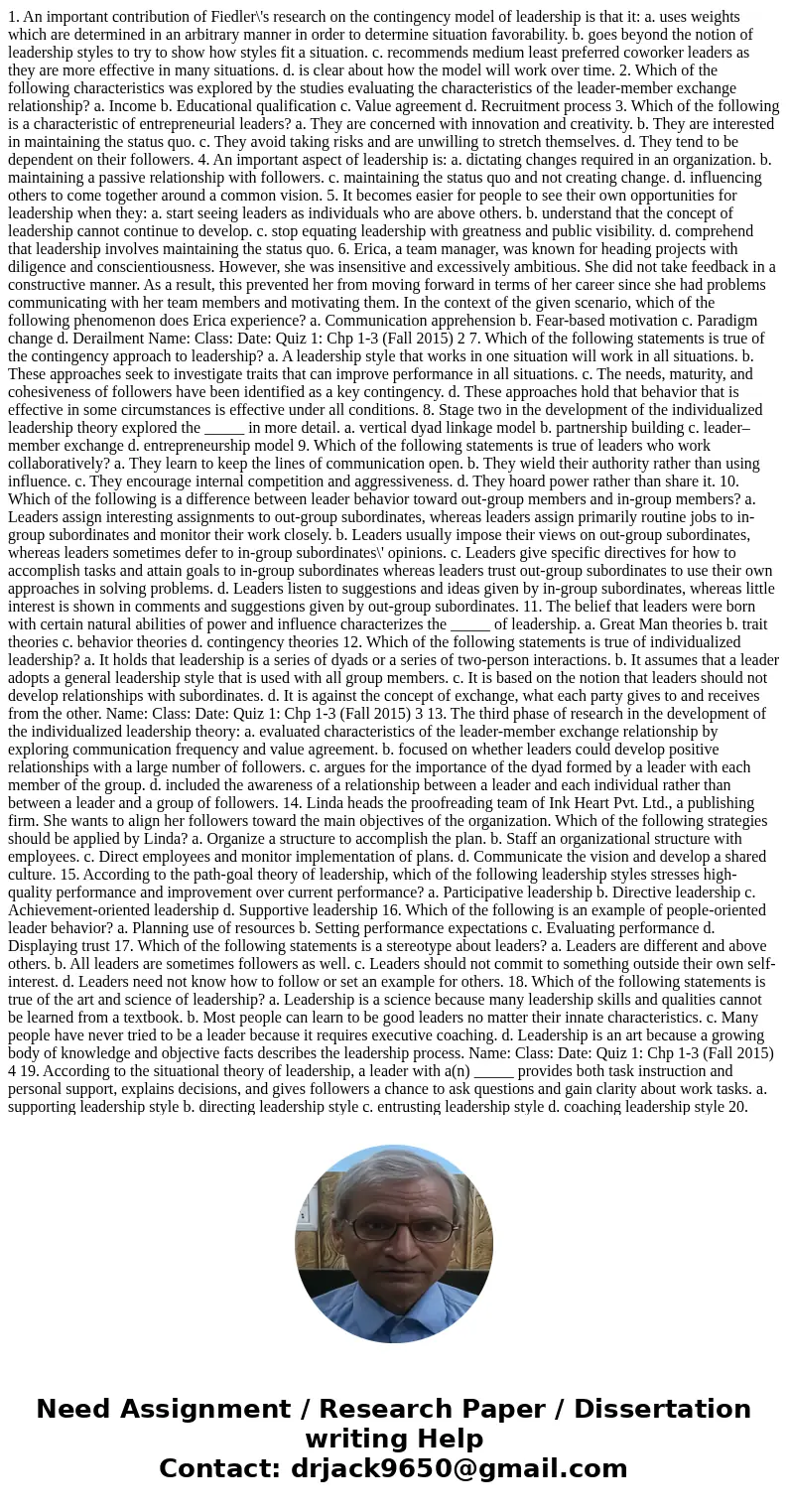
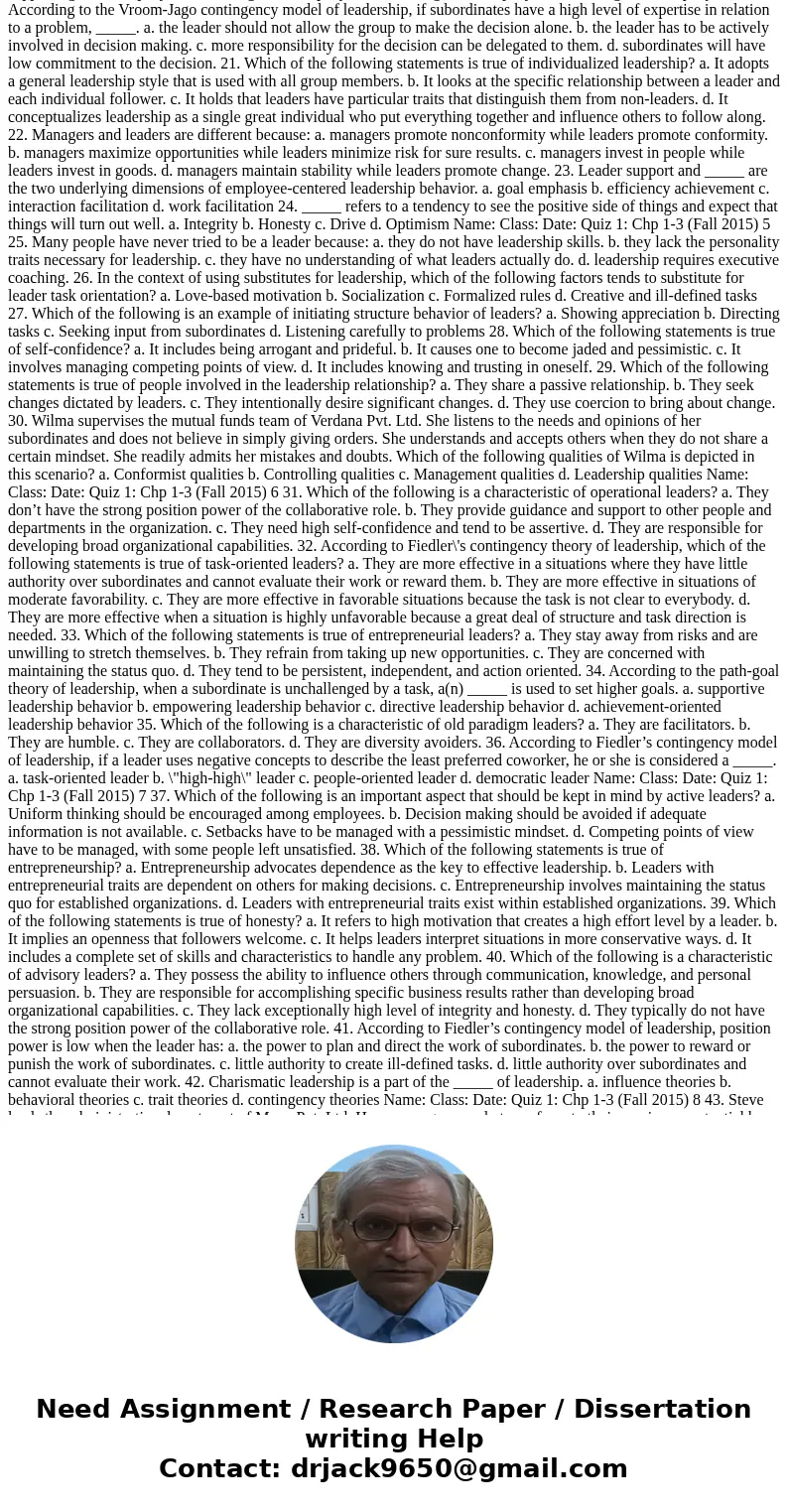
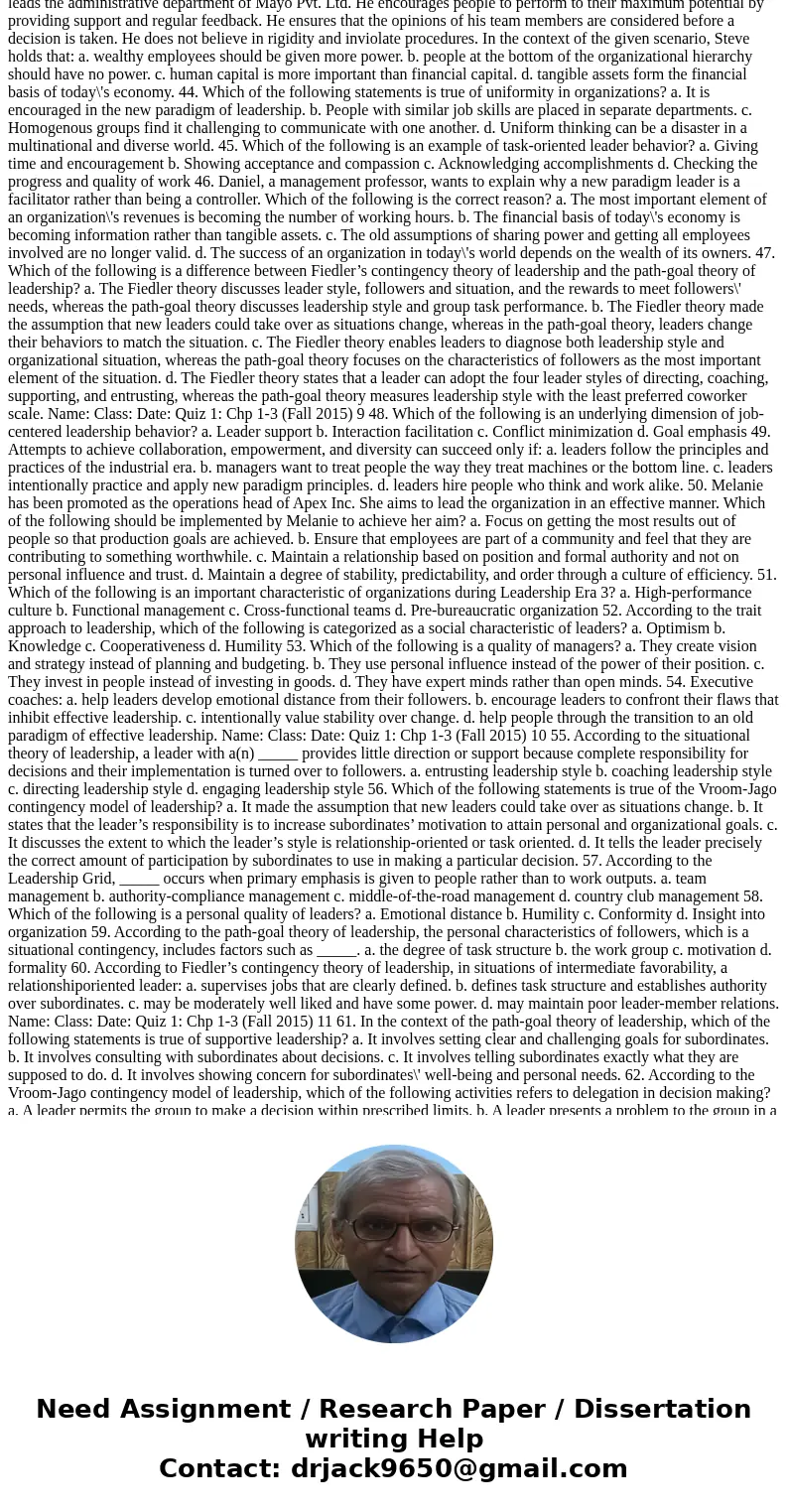
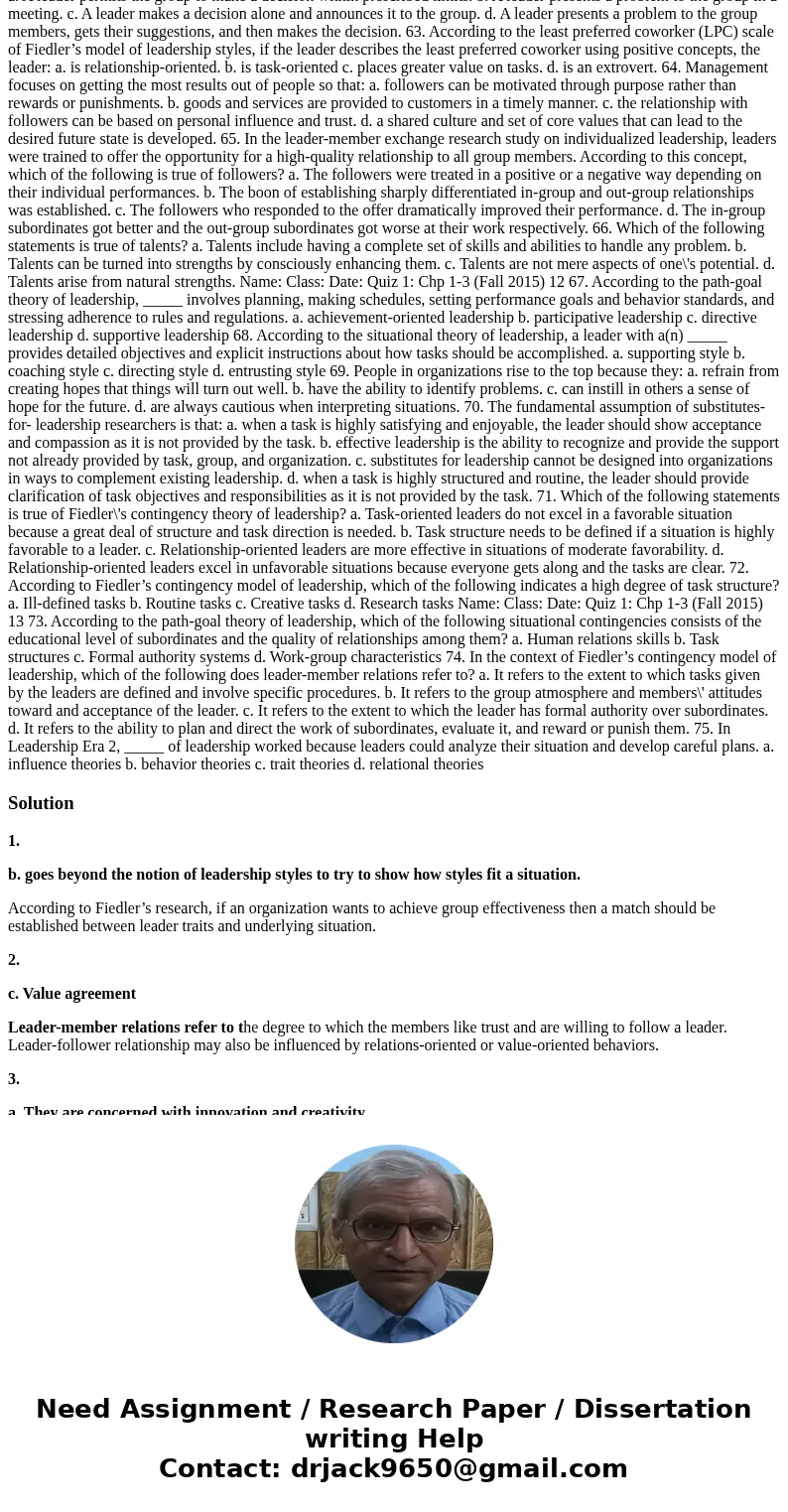
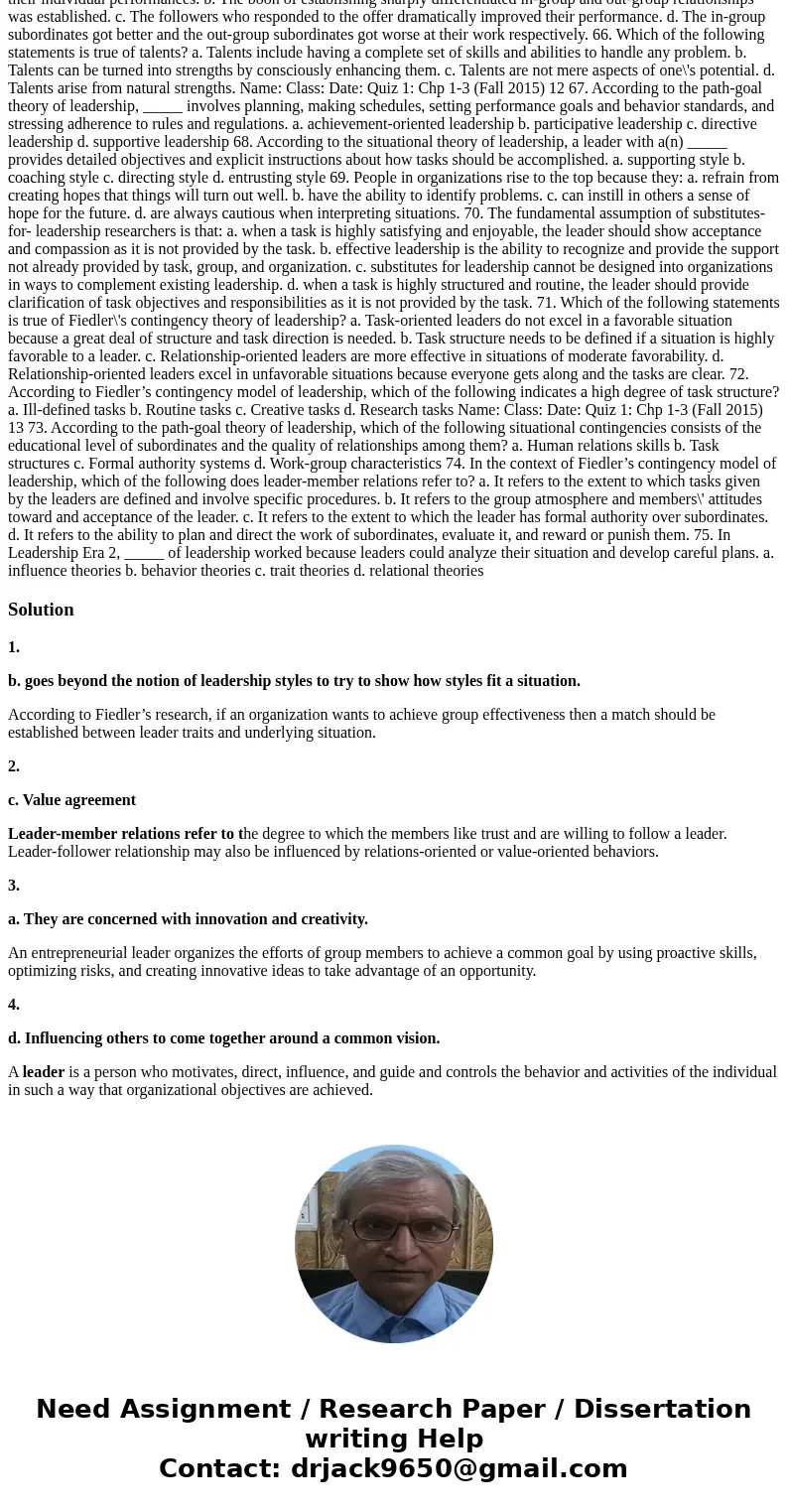
 Homework Sourse
Homework Sourse